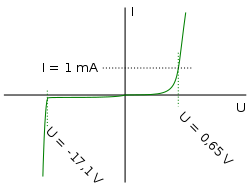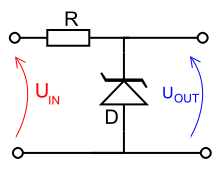Zener diode


A Zener diode is a type of diode that permits current in the forward direction like a normal diode, but also in the reverse direction if the voltage is larger than the breakdown voltage known as "Zener knee voltage" or "Zener voltage". The device was named after Clarence Zener, who discovered this electrical property.
A conventional solid-state diode will not allow significant current if it is reverse-biased below its reverse breakdown voltage. When the reverse bias breakdown voltage is exceeded, a conventional diode is subject to high current due to avalanche breakdown. Unless this current is limited by external circuitry, the diode will be permanently damaged. In case of large forward bias (current in the direction of the arrow), the diode exhibits a voltage drop due to its junction built-in voltage and internal resistance. The amount of the voltage drop depends on the semiconductor material and the doping concentrations.
A Zener diode exhibits almost the same properties, except the device is specially designed so as to have a greatly reduced breakdown voltage, the so-called Zener voltage. A Zener diode contains a heavily doped p-n junction allowing electrons to tunnel from the valence band of the p-type material to the conduction band of the n-type material. In the atomic model, this tunneling corresponds to the ionization of covalent bonds. A reverse-biased Zener diode will exhibit a controlled breakdown and allow the current, to keep the voltage across the Zener diode at the Zener voltage. For example, a diode with a Zener breakdown voltage of 3.2 V will exhibit a voltage drop of 3.2 V if reverse bias voltage applied across it is more than its Zener voltage. However, the current is not unlimited, so the Zener diode is typically used to generate a reference voltage for an amplifier stage, or as a voltage stabilizer for low-current applications.
The breakdown voltage can be controlled quite accurately in the doping process. While tolerances within 0.05% are available, the most widely used tolerances are 5% and 10%.
Another mechanism that produces a similar effect is the avalanche effect as in the avalanche diode. The two types of diode are in fact constructed the same way and both effects are present in diodes of this type. In silicon diodes up to about 5.6 volts, the zener effect is the predominant effect and shows a marked negative temperature coefficient. Above 5.6 volts, the avalanche effect becomes predominant and exhibits a positive temperature coefficient.
In a 5.6 V diode, the two effects occur together and their temperature coefficients neatly cancel each other out, thus the 5.6 V diode is the component of choice in temperature-critical applications.
Modern manufacturing techniques have produced devices with voltages lower than 5.6 V with negligible temperature coefficients, but as higher voltage devices are encountered, the temperature coefficient rises dramatically. A 75 V diode has 10 times the coefficient of a 12 V diode.
All such diodes, regardless of breakdown voltage, are usually marketed under the umbrella term of "zener diode".
Uses
Zener diodes are not widely used to regulate the voltage across a circuit. When connected in parallel with a variable voltage source so that it is reverse biased, a zener diode conducts when the voltage reaches the diode's reverse breakdown voltage. From that point it keeps the voltage at that value.

In the circuit shown, resistor R provides the voltage drop between UIN and UOUT. The value of R must satisfy two conditions:
- R must be small enough that the current through D keeps D in reverse breakdown. The value of this current is given in the data sheet for D. For example, the common BZX79C5V6[1] device, a 5.6 V 0.5 W zener diode, has a recommended reverse current of 5 mA. If insufficient current exists through D, then UOUT will be unregulated, and less than the nominal breakdown voltage (this differs to voltage regulator tubes where the output voltage will be higher than nominal and could rise as high as UIN). When calculating R, allowance must be made for any current through the external load, not shown in this diagram, connected across UOUT.
- R must be large enough that the current through D does not destroy the device. If the current through D is ID, its breakdown voltage VB and its maximum power dissipation PMAX, then .
A zener diode used in this way is known as a shunt voltage regulator (shunt, in this context, meaning connected in parallel, and voltage regulator being a class of circuit that produces a stable voltage across any load). In a sense, a portion of the current through the resistor is shunted through the Zener diode, and the rest is through the load. Thus the voltage that the load sees is controlled by causing some fraction of the current from the power source to bypass it—hence the name, by analogy with locomotive switching points.
These devices are also encountered, typically in series with a base-emitter junction, in transistor stages where selective choice of a device centered around the avalanche/zener point can be used to introduce compensating temperature co-efficient balancing of the transistor PN junction. An example of this kind of use would be a DC error amplifier used in a stabilized power supply circuit feedback loop system.
Note that because it is almost always the reverse breakdown property of the Zener diode which is useful, in circuit schematics the Zener diodes typically point in the opposite direction of traditional diodes - the arrows point in the opposite direction to the current.
See also
- Wikibooks:Zener diodes
- Avalanche diode
- Voltage stabiliser
- Voltage regulator tube
- transient voltage suppression diode
- Backward diode

